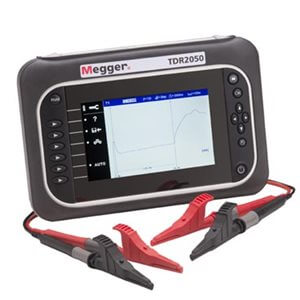Editor’s note: This article comes from Megger, a designer and manufacturer of portable electrical test equipment. Read the company’s blog postings here.

Designed for the location of faults in electrical power supply cables, the TDR2050 is a time domain reflectometer that’s dust and weatherproof to IP54.
Energy theft is rarely discussed in detail. Testing equipment is typically used to detect faulty or old equipment so it can be fixed or upgraded within a company’s closed system. With energy theft, the testers help combat this criminal act while finding and fixing safety hazards – such as when someone has hacked into the electrical grid illegally, and sometimes dangerously.
It is estimated that over $8 billion worth of energy is stolen each year, with the highest losses in India ($16.2 billion), Brazil ($10.5 billion) and Russia ($5.1 billion), according to Emerging Markets Smart Grid: Outlook 2015 study done by the Northeast Group, LLC. And, according to the U.S. Energy Information Administration, it is estimated that between one-half and two percent of electricity in the United States is lost to theft as well.
Energy theft can cost utilities tens to hundreds of thousands of dollars if they are not paying close attention to their meters. It is no longer like the old days when service personnel was sent out to check on installations and do meter readings. Today, nearly all readings are done remotely in the utility company’s office. Furthermore, stealing energy is easier than ever, with people knowing much more than they once did thanks to DIY projects and widespread knowledge through the internet. Let’s face it, you can Google or YouTube how to do just about anything these days.
With that said, how in the world do companies stop this from happening to them? Clearly, more boots on the ground can help stop this. But how? If the tampering isn’t something as obvious as someone turning a meter upside down so that it calculates backward, or noticing a magnet that has been attached to the meter that interferes with the inner workings of that meter, slowing down the rotation of the disc that calculates what you are using, how does it get detected?
For one, field techs need to be vigilant. Your most powerful tool is your eyes. Look to see if anything looks out of place, removed or replaced. Seals of meters should be checked regularly. Look for things like lights on in a home when power was cut off weeks ago. Does it appear that power is running on a property that doesn’t have an account with the utility company in the area? These are red flags and something to look into.
Once theft has been detected, certain testers, like time domain reflectometers, can be used to confirm the detection and pinpoint exactly where the energy is being stolen from on a line. These units can be connected directly to an energized network and eliminate the effect of dead zones produced by the pulse width of a conventional TDR and effectively measure the presence of T-connections in short distances.
Regardless of how companies detect and deal with energy theft, it is important to deal with. It is as serious as any other crime where theft is involved.
Filed Under: News




